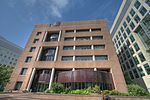World Wide Web Consortium
1994 establishments in the United StatesInternet Standard organizationsOrganizations based in Cambridge, MassachusettsOrganizations established in 1994Standards organizations in the United States ... and 5 more
Technology consortiaTim Berners-LeeWeb developmentWeb servicesWorld Wide Web Consortium

The World Wide Web Consortium (W3C) is the main international standards organization for the World Wide Web. Founded in 1994 and currently led by Tim Berners-Lee, the consortium is made up of member organizations that maintain full-time staff working together in the development of standards for the World Wide Web. As of 21 March 2022, W3C had 459 members. W3C also engages in education and outreach, develops software and serves as an open forum for discussion about the Web.
Excerpt from the Wikipedia article World Wide Web Consortium (License: CC BY-SA 3.0, Authors, Images).World Wide Web Consortium
Vassar Street, Cambridge Cambridgeport
Geographical coordinates (GPS) Address Nearby Places Show on map
Geographical coordinates (GPS)
| Latitude | Longitude |
|---|---|
| N 42.362055555556 ° | E -71.090833333333 ° |
Address
Ray & Maria Stata Center (32) (Building 32)
Vassar Street 32
02139 Cambridge, Cambridgeport
Massachusetts, United States
Open on Google Maps








